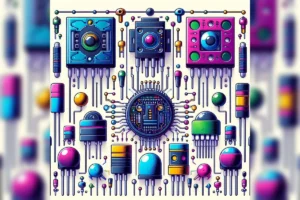Introduction:
In the rapidly evolving field of Very Large Scale Integration (VLSI), freshers need to acquire a diverse set of skills to stand out in the job market. Understanding and mastering key concepts and tools can significantly enhance your employability in this competitive industry.Here’s a detailed guide on the 25 essential VLSI topics you should focus on as a fresher.
Follow us on Twitter here
1. Boolean Algebra & Logic Gates
Boolean algebra forms the foundation of digital circuits. It involves the study of binary variables and logical operations.
Logic gates, which are the basic building blocks of digital circuits, perform these operations. Mastering these concepts is crucial for designing and analyzing complex digital systems.
2. Number Systems
Familiarize yourself with various number systems such as binary, decimal, and hexadecimal. These systems are integral to digital design and processing.
Understanding how to convert between these systems is a fundamental skill in VLSI.
3. Combinational Circuits
Combinational circuits are logic circuits whose outputs depend only on the current inputs.
Learning how to design and implement these circuits is essential for creating efficient digital systems.
4. Sequential Circuits
Sequential circuits, unlike combinational circuits, have memory elements that allow their outputs to depend on both current and past inputs. Understanding flip-flops and latches, which are the building blocks of sequential circuits, is vital for any VLSI designer.
5. Digital Design with Hardware Description Languages (HDLs)
HDLs such as Verilog and VHDL are used to describe and simulate digital circuits. Mastery of these languages enables you to create, test, and debug complex digital designs efficiently.
Advanced Digital Design
6. Finite State Machines (FSMs)
FSMs are used to model the behavior of sequential circuits. They are crucial for designing control units and other components in digital systems. Learning how to design and implement FSMs will enhance your ability to create robust digital circuits.
7. Data Path Design
Understanding the data path design involves creating the pathway through which data flows within a processor.
This includes designing various functional units like ALUs (Arithmetic Logic Units) and registers.
8. Control Unit Design
The control unit generates control signals to manage the data path.
Learning how to design control units is essential for creating efficient and functional processors.
9. Pipelining and Parallelism
Pipelining and parallelism are techniques used to improve the performance of digital circuits.
It involves dividing a process into stages with each stage executing in parallel, while parallelism involves performing multiple operations simultaneously.
10. Memory Design
Memory is a critical component in any digital system.
Understanding the principles behind different types of memory such as RAM and ROM, and how to design them, is crucial for any VLSI engineer.
Computer Architecture
11. Computer Organization
A solid understanding of computer organization, including the architecture of processors, memory hierarchy, and I/O systems, is essential for designing efficient digital systems.
12. Instruction Set Architecture (ISA)
ISA is the set of instructions that a processor can execute. Familiarity with various ISAs helps in understanding how different processors work and how to optimize code for them.
13. Pipelined Processors
Pipelining is a key technique used in modern processors to improve performance. Understanding how to design and implement pipelined processors will significantly enhance your skills as a VLSI designer.
14. RISC vs. CISC Processors
RISC (Reduced Instruction Set Computing) and CISC (Complex Instruction Set Computing) are two main processor architectures. Knowing the differences and applications of these architectures is essential for designing processors and optimizing their performance.
GlobalFoundries Acquires Tagore Technology’s GaN IP Portfolio | by techovedas | Jul, 2024 | Medium
15. Microcontrollers
Microcontrollers are compact integrated circuits designed for specific control applications.
Understanding their architecture and programming is essential for designing embedded systems.
VLSI Design Flow
16. Design Verification
Verification ensures that a design meets all specifications and functions correctly.
Learning various verification techniques and tools is crucial for ensuring the reliability of VLSI designs.
17. Synthesis
Synthesis involves converting HDL code into a gate-level netlist. Understanding the synthesis process and tools is essential for transforming your designs into physical circuits.
18. Static Timing Analysis (STA)
STA is used to analyze the timing performance of a VLSI design. It ensures that the design meets all timing requirements and operates at the desired clock frequency.
19. Placement and Routing
Placement and routing involve arranging the standard cells and routing the interconnections on a chip. Mastering these techniques is essential for creating efficient and manufacturable VLSI designs.
20. Power Optimization
Reducing power consumption is critical in VLSI design, especially for portable and battery-operated devices. Learning various power optimization techniques will help you create energy-efficient designs.
Testing
21. Fault Modeling
Fault modeling involves creating models of possible faults in a VLSI design. Understanding different fault models is essential for designing robust and testable circuits.
22. Scan Design
Scan design techniques improve the testability of a VLSI design. Learning these techniques will help you create designs that are easier to test and debug.
23. Boundary Scan (BScan)
BScan is a standard for testing integrated circuits. Understanding how to implement and use BScan is essential for ensuring the reliability and testability of your designs.
24. DFT (Design for Testability)
DFT techniques make a VLSI design easier to test. Learning these techniques will enhance your ability to create designs that are both functional and reliable.
Other Important Skills
25. EDA Tools
Electronic Design Automation (EDA) tools are used throughout the VLSI design flow. Familiarizing yourself with popular EDA tools like Cadence and Synopsys will greatly enhance your productivity and effectiveness as a VLSI engineer.
Conclusion
Mastering these 25 Essential VLSI Topics will provide you with a solid foundation in VLSI design and significantly enhance your employability in the industry. While this is not an exhaustive list, focusing on these fundamentals will prepare you to tackle the challenges of this exciting field. Whether you are designing cutting-edge processors or developing robust memory systems, these skills will serve as the bedrock of your VLSI career.







